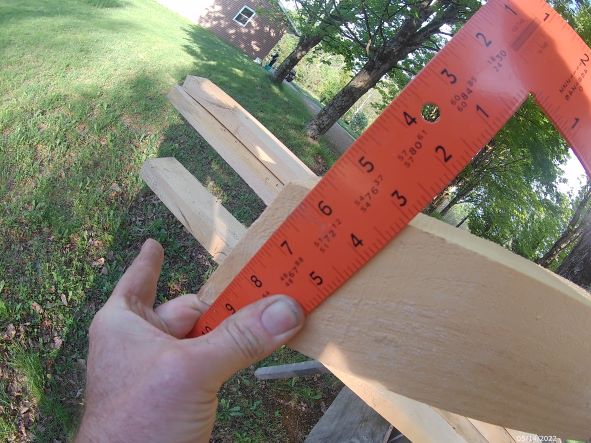I extended my rear roof overhang 14 inches this year (2018). I would like to share with you how it is done and what it cost me.
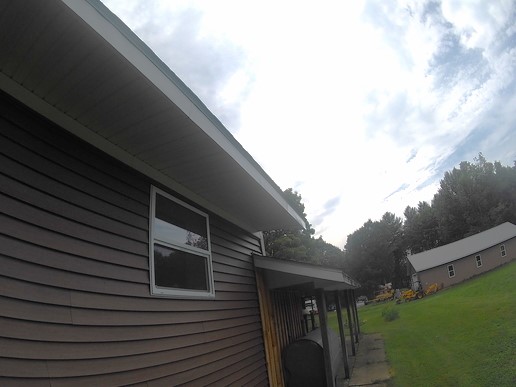
My cost of extending a roof overhang. The cost of extending my 30-foot-long roof overhang 14 inches was (in 2018 $340 or $11.50) now in 2022 would have cost $567 or $19.00 per running foot for materials. This cost did not include any labor or waste disposal fees. A good estimate for a contractor to do this same roof overhang extension would range from $100 to $250+ per running foot.
This depends on your area.
I had some issues with water dripping on my siding and some staining had occurred.
In the rest of the article, I will explain what is involved with extending the roof overhang and what the project cost.
Basic roofing terms
- Rafters (2-inch material that holds the roof up)
- Sheeting is the wood that covers the rafters (plywood, OSB board, or 1-inch boards)
- Underlayment (a light layer under the shingles, for example, tar paper or weather barrier)
- Roofing (what you see on top, for example, asphalt shingles, steel, slate, or clay tile)
- Facia (the wood board under the finish trim or the finish trim you see on the edge)
- Soffit (the finish material under the overhang, for example, wood, vinyl, or cement composite)
What steps are involved in extending the overhang
- Set up scaffolding. You need to get up to the area that you are going to extend. (follow safe working procedure, falling off a ladder or scaffolding can cause severe injury or death) I can tell you with all sincerity, I have done it, it does hurt when you hit the ground.
- Strip off the first 3 layers (or more) of shingles going up the roof the length of the work area. Stripping off the shingles provides you with a clean area to weave the new shingles into the old roof. This is also the time you may discover that you have had water damage and the job just got bigger.
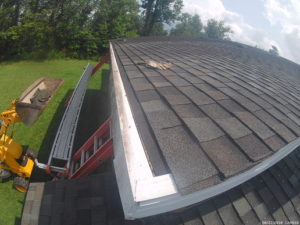
- Remove the drip edge, if you are careful you may be able to reuse it. I did need to buy more because I was lacking some after the extension. You will be too.

- Remove the facia covering, I have aluminum so I saved it and reused what I could. Also,
- I had to buy more because of the extension.
- Remove some of the sheeting exposing the rafter (12″ – 16″)
- Repair any rotten wood if you find any.
- This is a good time to inspect the insulation baffles (rafter vents) and install them if they are missing.
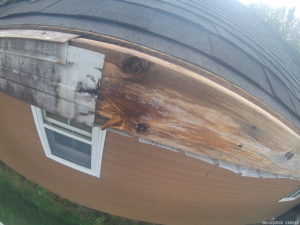
- Cut the extensions out of the same material used for the rafters. The length of the extensions should extend up along the side of the rafter from 12″ to 24″. This allows you to get a good connection splice on the rafter.
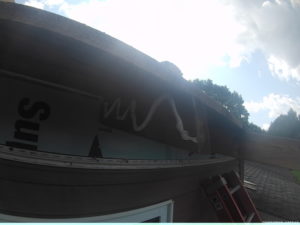
- Add adhesive to the rafters and attach the extensions to the side with screws or nails.
- Cut the tails to length and attach the facia board.
- Add the new sheeting to the extensions making sure it overlaps the original rafters, this helps hold the overhang in place.
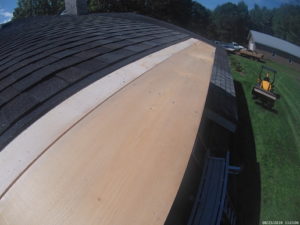
- Install the drip edge, and new roof material
- Install the new soffit material and the facia material
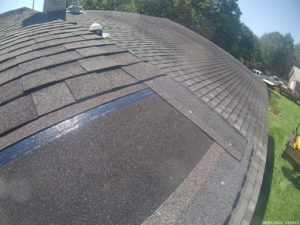
- Stand back and admire your work.
*This should give you an idea of what steps a contractor must also complete*
Updated price schedule for 2022
- 2×6’s for the rafter tails and new facia board $95
- Adhesive $12
- Sheeting to match the existing sheeting $75
- Roofing underlayment and shingles (self-adhesive weather barrier and fiberglass shingles) $125
- Drip edge and finish facia trim (aluminum) $110
- Soffit (vinyl) $150
2022 $ 19.00 per running foot cost
2018 prices
Where did I come up with the $11.50 per running foot cost
This is how I came up with the running foot cost. I took the cost of what I had to buy and put a price on the materials that I already had or reused
- 2 x 6’s for the rafter tail extension and new facia board $47
- Adhesive $8
- Sheeting to match the existing sheeting 1-inch boards $36
- Roofing underlayment and shingles (self-adhesive weather barrier and asphalt fiberglass shingles) $93
- Drip edge and finish facia trim (aluminum) $36
- Soffit (vinyl) $120
The cost of the materials in the project was $340 on 7/9/2018 in upstate NY
Why did I place a price range for the contractor to do the work
The price range for the contractors will change for the area you live in.
The other factor that will influence the labor cost is how big the job is.
- A 30-foot-long 12-inch overhang will cost more per running foot than the same 100-foot job. The contractor will charge you for a full day of labor even if it only took 5 hrs.
- The amount the contractor pays his workers
- If other work is being done at the same time (new roof or siding)
- How high up the project is (single story or 2 or more stories)
- Type of materials (slate roof or asphalt shingle) (vinyl or cement board soffit)
- If rain gutters need to be removed and reinstalled
All jobs are different and it is hard to place a solid price for the labor.
Will where I live to make the cost of extending a roof overhang change
Yes, where you live does make a difference.
The cost of materials for your region.
The cost of labor for your region.
The way you need to build will change the cost. If you live in a wind load or snow load region makes a difference. I live in a heavy snow load area and we build to 50 lb per square foot of snow loads. My sister lives in Florida and would need to build for high wind loads. Even the type of house you have will affect the price, a 4 story overhang is going to cast more to extend than a single-story house.
What kind of issues can you find when you open up the roof that will drive up the cost?
The surprises are endless when you open up a roof. I have seen lots of water damage and rot, lots and lots of rot from years of neglect. Rodent and insect damage is always a concern. It is amazing how much wood carpenter ants can eat or the damage a squirrel can do when they make a home in your soffit. Bee’s are always fun.
Do you need a building permit to do this work?
You may need a building permit to do this work. It all depends on the local rules governing building codes. You are changing the configuration of the roof and it might not be a bad idea to have the building inspector take a look at the job the contractor is doing.
Do you need a contractor to do this work?
If you are handy and don’t mind heights and have the tools then you can tackle this project on your own. If you are going to try this on your own only do one side of the roof at a time. The last thing you need is the rain to start coming down with the roof open. Been there and done that, not any fun repairing sheetrock and painting.
If you don’t have the time or the tools it may be wise to hire the job out.
What to look for in hiring a contractor
This is off the groundwork so insurance is a must. The contractor is working on your house and your homeowners are only going to cover a limited amount of medical bills if they fall and get hurt. Contractors with insurance charge more and it is well worth it.
Roofing experience is also a must. The contractor is working with the moisture control point on the roof of your house and they need to know how to keep the water out. I have seen work that has been done that cost thousands of dollars in water damage and rot.
Never pay for the work upfront. A good contractor may ask for a good-faith down payment which is normal. A good contractor will never ask for the full amount up front.
Make sure there is a signed work agreement (contract) with a scope of work. Scope of work with a contract makes life so much easier at the end of the job. Any extras should have a written price and description of the extra. If it is possible have the contractor show you the extra he is going to repair (most likely rot) with a before and after photo.
Try to get more than one price. With a small job like extending an overhang your options are going to be limited with contractors who are willing to look at your job. Just remember the lowest price may not be the best price in the end. Talk with the contractor and if possible ask for past customers you can contact. A good contractor will be busy and it may take some time to “fit you in”
It may be easier to get more contractors to look at your project if you combine it with other work.
Will the new overhang match the rest of the house
The fast answer is probably not. The roofing is not going to be a perfect color match because of the sun bleaching the roofing or the batch run is going to be different so the colors of the stone used on shingles will be different. You can get a close match but more than likely the colors are going to be off. My shingles were discontinued so my match is way off.
What materials can you save for reuse to save money
- Facia board and trim
- Drip edge
That is about it, any shingles stripped off are of no use and the soffit will be too short to use again.
Is the process any different for extending a gable end overhang?
The process is really the same because you still need to strip off the shingles and attach the extensions back into the rafters. There will be more work involved in weaving the new shingles into the old but the process is really the same. Things really change because the working platform is no longer on a level plane and the people doing it will be working off ladders making it cost more.
Why extend a roof overhang
Extending a roof overhang will get the water draining off the roof away from the siding and the foundation. Water splashing on the siding causes water staining, mold growth, rot and will cost lots of money for future repairs.
Moving the water away from the foundation will keep your basement drier decreasing the chance of mold growth inside of your house.
Suggested projects to do at the same time as the overhang extension
- New roofing
- Additional roof ventilation
- Moving any problem plumbing vents
- Gutters
- Removal of problem trees or landscaping
- Upgrade your house insulation
- New windows or doors
The list could be quite long. The more projects you can bundle the more contractors will be willing to give you a price.
I hope this article has helped you in some way
10/8/2018 updated 7/1/2022
Gary


